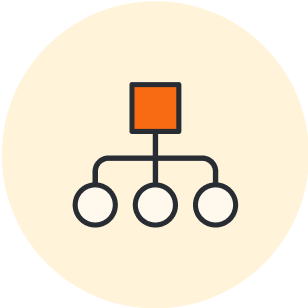In the U.S., more than 60% of network downtime costs businesses over $100,000. To put this in perspective, in 2021, just an hour of downtime cost Amazon $34 million in sales!
To avoid costly downtime, severed relationships with users, and tarnished brand reputation, companies need to design their software to fail.
Designing software to fail means designing to automate software restoration and solutions. Software that is designed to fail uses these safeguards to help avoid massive service interruptions—and keep design teams in an agile, solution-oriented mindset.
Let’s walk through some strategies for how to design software that fails. It’s not a question of if; it’s a question of when, and savvy businesses are always prepared for the inevitable.
Why is it important to design your software to fail?
Regardless of your design process, there are components outside of our control that will fail. That’s why designers and companies need to prepare to avoid downtime and effectively manage it when it does happen.
Think about the last major outage you experienced with your favorite software. From email providers to workflow tools or even messaging applications, these outages occur all the time—and when they do, we’re always surprised at how massively disruptive they are to our day-to-day work. Users immediately head to down detection websites or to social media channels to learn more and even complain about the outage.
Designing for failure enables your systems to automatically self-recover as much as possible. This minimizes downtime and disruption and builds resiliency into your systems from the get-go.
How to design software to fail
There are five key building blocks to designing software to fail and recover quickly:
1. Build redundant components
Redundancy is the duplication of critical components or functions in a system to increase the system’s reliability. Think of it as building a fail-safe and then building a fail-safe to that fail-safe again and again.
It’s crucial never to rely on a single component for the major functionality of your design. Instead, build redundant cloud components, ideally with minimal or no common points of failure.
2. Set up automation
To mitigate against major outages, test, test, test, and test some more and automate.
By automating the software build, promotion, and release processes, companies can better control software development and reliably scale software production—and leave less chance for error. To accomplish this, an increasing number of companies need to invest in automation engineers to automate business, IT, and development processes.
3. Plan for scalability
When designing to fail, you should also plan to scale. The two principles go hand in hand. Companies scale design efforts to meet customer demand or scale hiring to meet the needs of the business; engineers also build scalability and elasticity into the software. Building scalability into your systems allows your software to accommodate higher workloads, and elasticity gives your system the ability to adjust resources to adapt to different loads dynamically, usually in relation to scaling out.
In theory, each version of an app or product is a better version than the last and better able to meet the demands of its users. Scalability is essentially an increase in capacity. If your team is building modular or redundant components, then you will almost certainly have a bottleneck or issue somewhere in your product, given that fallibility is inevitable in software development.
Any shared resource in your network is a potential point of failure that will limit your scalability at best and cause a cascading set of problems at worst. When you plan for scalability, you’re also preparing for these bottlenecks to occur.
4. Focus on reliability
Knowing that software and cloud service failures are inevitable, the focus can shift to containing and recovering from those failures quickly to boost reliability. Engineering practices like fault modeling and fault injection are necessary elements of a continual release process that builds more reliable software and cloud systems.
5. Build with elasticity
Some days, your software, app, or cloud platform will place more demands on you than others. By building in elasticity, you can increase or decrease the scalability or capacity of the system by adjusting the number of deployed services.
If you’ve also set up automation, as previously discussed, you can create a reactive system that adapts to changes in demand or load automatically. With this type of elasticity, flexibility, and reactivity in place, you can avoid failures due to system overloads.
In a world that requires more flexibility and agility than ever, planning and designing for failure is key to success. Resiliency is more valuable than perfection. Failures will happen, but the tools and systems built to minimize disruption will boost reliability and increase consumer trust.

Learn more about why scalability, reliability, and availability are essential for meeting customer demand, ensuring seamless performance, and providing global access.
Read nowAbout Lucidchart
Lucidchart, a cloud-based intelligent diagramming application, is a core component of Lucid Software's Visual Collaboration Suite. This intuitive, cloud-based solution empowers teams to collaborate in real-time to build flowcharts, mockups, UML diagrams, customer journey maps, and more. Lucidchart propels teams forward to build the future faster. Lucid is proud to serve top businesses around the world, including customers such as Google, GE, and NBC Universal, and 99% of the Fortune 500. Lucid partners with industry leaders, including Google, Atlassian, and Microsoft. Since its founding, Lucid has received numerous awards for its products, business, and workplace culture. For more information, visit lucidchart.com.
Related articles
Cloud computing 101: The interrelationship of scalability, reliability, and availability
As you research cloud computing, you've probably heard terms like "scalability," "reliability," and "availability." Learn the difference between these terms and how each benefits your business.
How to release software faster without compromising quality
Releasing software forces companies to make a difficult choice between quality vs. speed. See our software release strategies to get the best of both worlds.
Continuous deployment 101: Best practices for the popular engineering approach
In today’s fast-paced development environment, businesses and organizations have to move quickly to remain competitive, so many of them have switched to more agile disciplines, including continuous deployment. Learn best practices for continuous deployment, the ongoing delivery of software features.

